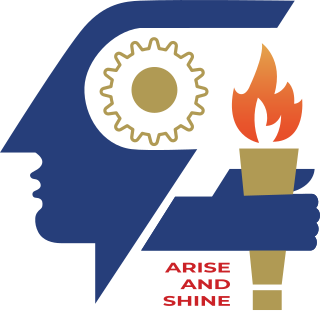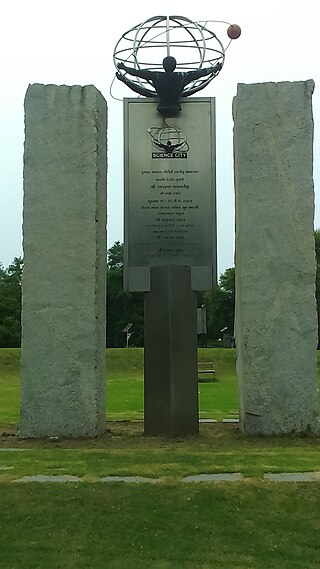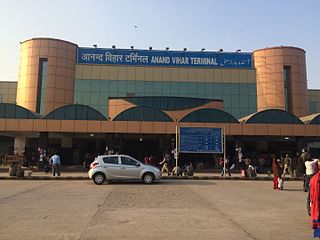
The Science and Industry Museum in Manchester, England, traces the development of science, technology and industry with emphasis on the city's achievements in these fields. The museum is part of the Science Museum Group, a non-departmental public body of the Department for Digital, Culture, Media and Sport, having merged with the National Science Museum in 2012.

Gandhinagar is the capital of the state of Gujarat in India. Gandhinagar is located approximately 23 km north of Ahmedabad, on the west central point of the industrial corridor between the megacities of Delhi and Mumbai.

The Mass Transit Railway (MTR) is a major public transport network serving Hong Kong. Operated by the MTR Corporation (MTRCL), it consists of heavy rail, light rail, and feeder bus services, centred around a 10-line rapid transit network, serving the urbanised areas of Hong Kong Island, Kowloon, and the New Territories. The system encompasses 245.3 km (152.4 mi) of railways, as of December 2022, with 179 stations—including 99 heavy rail stations, 68 light rail stops and 1 high-speed rail terminus.

The Tech Interactive is a science and technology center that offers hands-on activities, labs, design challenges and other STEAM education resources. It is located in downtown San Jose, California, adjacent to the Plaza de César Chávez.

Indian Railways is a statutory body under the ownership of the Ministry of Railways of the Government of India that operates India's national railway system. As of 2023, it manages the fourth largest national railway system by size with a track length of 132,310 km (82,210 mi), running track length of 106,493 km (66,172 mi) and route length of 68,584 km (42,616 mi). As of August 2024, 96.59% of the broad-gauge network is electrified. With more than 1.2 million employees, it is the world's ninth-largest employer and India's second largest employer.

The Chennai Mass Rapid Transit System, commonly referred to as Chennai MRTS, is a metropolitan rail transit system in Chennai, India. It is operated by Southern Railway of the state-owned Indian Railways. Opened in 1995, it was the first elevated railway line in India. The railway line runs from Chennai Beach to Velachery, covering a distance of 19.34 km (12.02 mi) with 18 stations and is integrated with the wider Chennai suburban railway network.

Pakistan Railways is the national, state-owned railway company of Pakistan with its headquarters in Lahore. Founded in 1861 as the North Western State Railway and headquartered in Lahore, it owns 7,789 kilometres of operational track across Pakistan, stretching from Peshawar to Karachi, offering both freight and passenger services, covering 481 operational stations across Pakistan.

Karunya Institute of Technology and Sciences, formerly Karunya University, is a private deemed university in Coimbatore, Tamil Nadu, India. It was founded by D. G. S. Dhinakaran and his son Paul Dhinakaran.
Navi Mumbai International Airport is an international airport being constructed in Ulwe, Navi Mumbai, Raigad district, Maharashtra, India. When completed, it will become the second airport of the Mumbai Metropolitan Region, serving alongside Mumbai's existing Chhatrapati Shivaji Maharaj International Airport.

Gujarat Science City is a science education and entertainment centre located in Ahmedabad, Gujarat, India. Opened in 2002 and expanded in 2021, it has an IMAX 3D theatre; exhibitions on science, space, energy park, life science park, planet earth, hall of science, musical fountain, thrill ride, plants, nature and robotics; an aquarium, an aviary and a butterfly park; as well as other facilities.

Jawahar Navodaya Vidyalaya (JNV) is a system of central schools for students predominantly from rural areas in India, targeting socially and economically backward students who lack access to accelerated learning due to financial, social and rural disadvantages.

Anand Vihar Terminal is a railway station in the Anand Vihar locality of Delhi, India. It is under the administrative control of the Delhi Division of the Northern Railway zone of the Indian Railways.

The Delhi Metro is a rapid transit system which serves Delhi and its adjoining satellite cities of Ghaziabad, Faridabad, Gurugram, Noida, Bahadurgarh and Ballabhgarh in the National Capital Region of India. The system consists of 10 colour-coded lines serving 256 stations, with a total length of 350.42 kilometres (217.74 mi). It is India's largest and busiest metro rail system and the second-oldest, after the Kolkata Metro. The metro has a mix of underground, at-grade, and elevated stations using broad-gauge and standard-gauge tracks. The metro makes over 4,300 trips daily.

The Birla Institute of Technology & Science, Pilani is a private deemed university in Pilani, Rajasthan, India. It focuses primarily on higher education and research in engineering and sciences. BITS Pilani was one of the first six institutes in India to be declared Institution of Eminence. According to 2012 data, BITS Pilani has an acceptance rate of 1.47%, making it one of the most exclusive technical universities in the world.

Rapid Metro Gurgaon is a light metro system serving the city of Gurgaon, Haryana, India. Rapid Metro connects the commercial areas of Gurgaon, and acts as a feeder link to the Delhi Metro with an interchange with its Yellow Line at Sikanderpur metro station.

The Kollam–Sengottai railway line is a railway line in South India which connects Kollam Junction in Kerala state and Sengottai in Tamil Nadu. The Quilon–Shencottah railway line was the first railway line in the erstwhile Travancore state and is more than a century old. The Kollam–Sengottai section is part of the Kollam–Chennai metre-gauge rail route commissioned by the British in 1904. The line has been completely converted to broad gauge and is now fully operational from Kollam Junction to Shengottai. It is going to be the important cargo transportation line connecting Vizhinjam container port and South Indian States.
Kerala Science Congress is an annual gathering of Kerala-based scientists and scholars organised by Kerala State Council for Science, Technology and Environment (KSCSTE) for revitalizing Research and Development activities in Kerala and to identify new talents in scientific research in Kerala. KSCSTE is an autonomous body constituted by the Government of Kerala. The gathering features talks by invited scientists, presentations of research papers and awards of various prizes.
The Kuldiha Wildlife Sanctuary is located at the Balasore district of Odisha, India. The sanctuary is spread across 272.75 km2 (105 sq mi) in the Chota Nagpur Plateau region. It is connected with Simlipal National Park via the Sukhupada and Nato hill ranges.

The Rewari Railway Heritage Museum is a railway museum in Delhi NCR at Rewari city in Haryana, India. Built in 1893, it is the only surviving steam locomotive shed in India, and houses some of India's last surviving steam locomotives as well as the world's oldest still-functional 1855-built steam locomotive the Fairy Queen. It is located 400 m (1,300 ft) north of the entrance of the Rewari railway station, 50 km (31 mi) from Gurgaon and 79 km (49 mi) from the National Rail Museum at Chanakyapuri in New Delhi.

Karachepone N. Ninan is an ecological economist. Dr. Ninan was born in Nairobi, Kenya where he had his early school education. Thereafter he relocated to India where he continued his high school and college education.
























